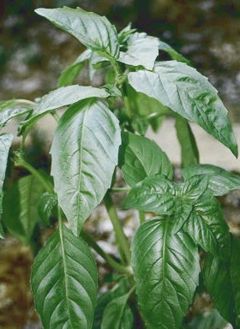|
 Basil is also known as
Sweet Basil or Tulsi. It is a tender low-growing herb that is grown as a
perennial in warm, tropical climates. Basil is originally native to India
and other tropical regions of Asia, having been cultivated there for more
than 5,000 years. It is prominently featured in varied cuisines throughout
the world including Italian, Thai, Vietnamese and Laotian. It grows to
between 30–60 cm tall, with opposite, light green, silky leaves 3–5 cm long
and 1–3 cm broad. The flowers are quite big, white in color and arranged in
a terminal spike. The plant tastes somewhat like anise, with a strong,
pungent, sweet smell. Basil is very sensitive to cold, with best growth in
hot, dry conditions. While most common varieties are treated as annuals,
some are perennial, including African Blue and Holy Thai basil. Basil is also known as
Sweet Basil or Tulsi. It is a tender low-growing herb that is grown as a
perennial in warm, tropical climates. Basil is originally native to India
and other tropical regions of Asia, having been cultivated there for more
than 5,000 years. It is prominently featured in varied cuisines throughout
the world including Italian, Thai, Vietnamese and Laotian. It grows to
between 30–60 cm tall, with opposite, light green, silky leaves 3–5 cm long
and 1–3 cm broad. The flowers are quite big, white in color and arranged in
a terminal spike. The plant tastes somewhat like anise, with a strong,
pungent, sweet smell. Basil is very sensitive to cold, with best growth in
hot, dry conditions. While most common varieties are treated as annuals,
some are perennial, including African Blue and Holy Thai basil.
Culinary use
Basil is most commonly recommended to be used fresh; in cooked recipes it is
generally added at the last moment, as cooking quickly destroys the flavor.
The fresh herb can be kept for a short time in plastic bags in the
refrigerator, or for a longer period in the freezer, after being blanched
quickly in boiling water. The dried herb also loses most of its flavor, and
what little flavor remains tastes very different, with a weak coumarin
flavor, like hay.
Mediterranean and Indochinese cuisines frequently use basil, the former
frequently combining it with tomato. Basil is one of the main ingredients in
pesto—a green Italian oil-and-herb sauce from the city of Genoa, its other
two main ingredients being olive oil and pine nuts. The most commonly used
Mediterranean basil cultivars are "Genovese", "Purple Ruffles", "Mammoth",
"Cinnamon", "Lemon", "Globe", and "African Blue". Chinese also use fresh or
dried basils in soups and other foods. In Taiwan, people add fresh basil
leaves into thick soups. They also eat fried chicken with deep-fried basil
leaves.
Basil is sometimes used with fresh fruit and in fruit jams and sauces—in
particular with strawberries, but also raspberries or dark-colored plums.
Arguably the flat-leaf basil used in Vietnamese cooking, which has a
slightly different flavor, is more suitable for use with fruit.
From Wikipedia
|